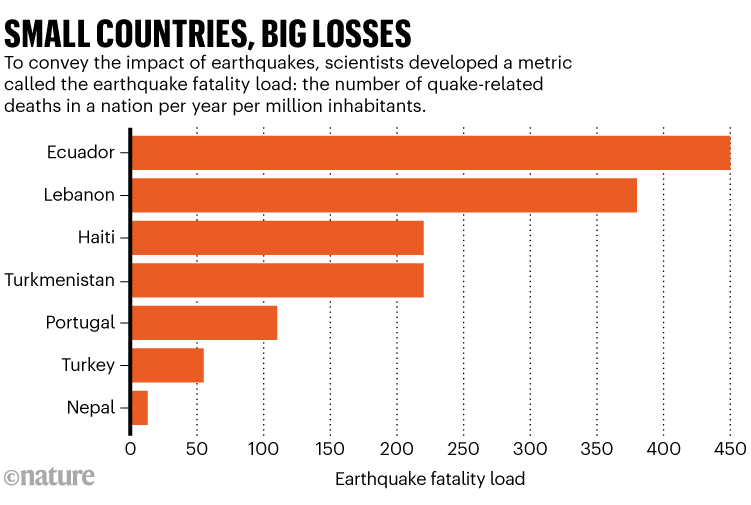Nations such as Japan and Indonesia make headlines because of their frequent earthquakes. But these countries are not the ones that have been most affected by quake-related deaths, according to a study1 that included the analysis of centuries-old earthquake fatality records.
Ecuador, Lebanon, Haiti and Turkmenistan top the list of countries with the highest “earthquake fatality load”, the study’s metric for the impact of a nation’s quake-related deaths relative to its population size. This metric will be “useful to highlight countries where additional hazard and risk studies should be carried out”, says Vitor Silva, a risk engineer at the Global Earthquake Model Foundation in Pavia, Italy, who was not involved in the work.
Unequal burden
Table of Contents
Earthquakes have claimed high numbers of lives in populous nations such as China, but the study’s authors sought to understand which countries incur the largest relative burden of such deaths. To do so, the researchers drew on their previously compiled catalogue2 of deadly earthquakes and fatality reports, which is “one of the most complete I have ever seen”, Silva says. That database includes records of quake-related deaths dating back more than 500 years.
The researchers analysed data from 35 nations and regions that have accrued at least 10,000 earthquake-associated deaths since 1500. The authors aggregated annual quake-related deaths and population sizes in each country for the years that had sufficiently accurate records. From this data set, they derived each country’s earthquake fatality load, the average number of quake-related deaths per year per million residents (see ‘Small countries, big losses’).

Source: Ref. 1.
The fatality load’s simplicity could make it a useful metric for assessing the risk and communicating it to decision makers, Silva says.
A country’s fatality load depends not only on the frequency and strength of its quakes, but also on factors such as its population size, the earthquake resistance of its infrastructure and its ability to respond to disasters. These factors might explain the relatively low fatality load of countries that lie along major fault lines, such as Nepal (ranked 27th), Japan (ranked 28th) and Indonesia (ranked 31st).
The aftermath of recent earthquakes supports the authors’ findings. When a quake of magnitude 7.5 hit Japan in January, 241 people died. The 2023 earthquake that hit Turkey (ranked 11th) and Syria (ranked 19th) was roughly three times stronger than the one in Japan, with a magnitude of 7.8, yet had a death toll roughly 200 times higher. This was mainly because the quake affected large numbers of communities with inadequate infrastructure and because of a slow rescue response.
Surprising findings
Ecuador’s ranking at the top initially surprised the study’s lead author Max Wyss, a retired seismologist at the International Centre for Earth Simulation in Geneva, Switzerland. But Wyss notes that Ecuador has had several deadly earthquakes over the years, and their frequency combined with the nation’s small population mean that such fatalities “are a big hit for the country”.
On a more encouraging note, the researchers found a steady decrease in the fatality load over time across all analysed countries. They attribute this change to improvements in construction and a steady migration from rural to urban areas with stronger buildings and better disaster responses.
